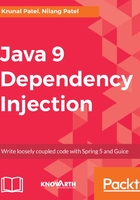
Summary
In the software paradigm, it's always recommended to break the whole system down into small modules that can work independently for specific tasks. DIP is one of the important principles to build a modular system. In this chapter, we saw how high-level modules should not depend on low-level modules, and both should depend on abstraction (the concept of DIP).
We learned in detail how we can achieve DIP through IoC. Setting inversion of control makes a system loosely coupled. We also learned various design patterns such as factory, service locator, and dependency injection to implement IoC.
After that, we learned about the various types of the dependency injection pattern. Finally, we discussed IoC containers and how they're useful when building modular systems.
In the next chapter, we will talk about modularity concepts and dependency injection in Java 9.